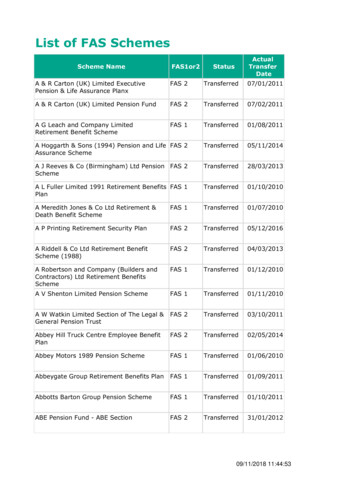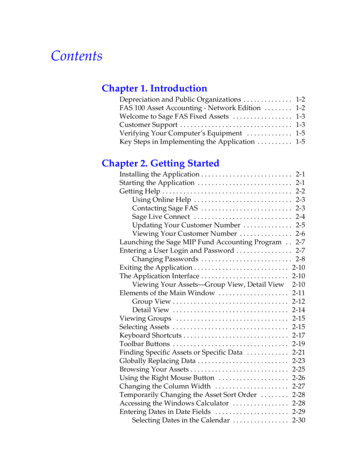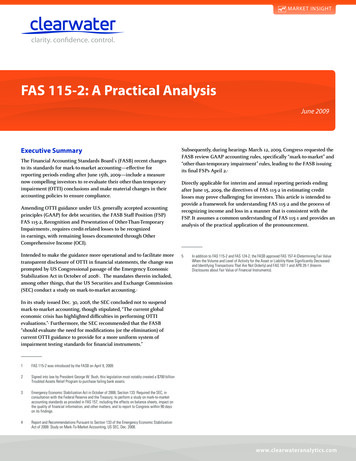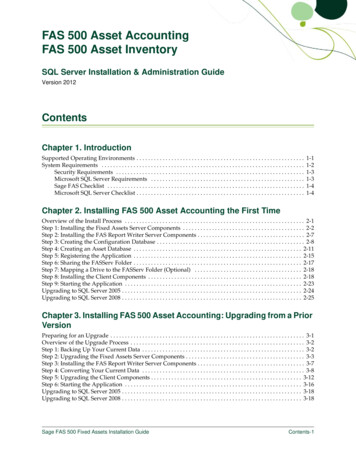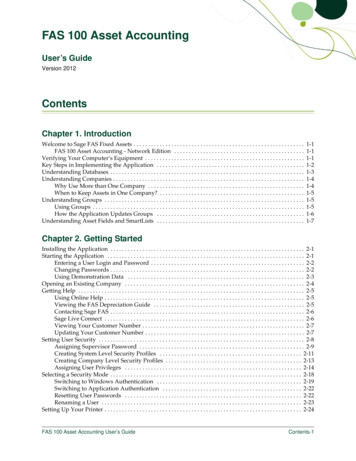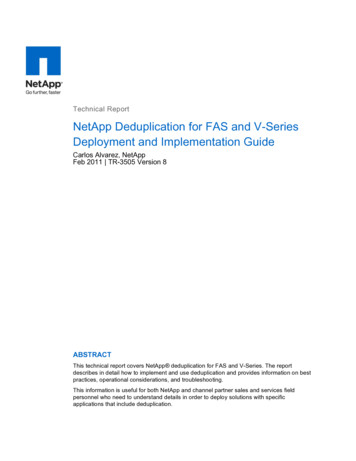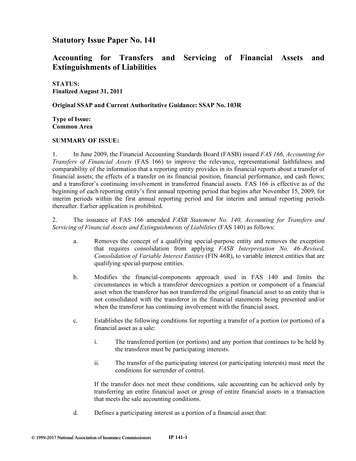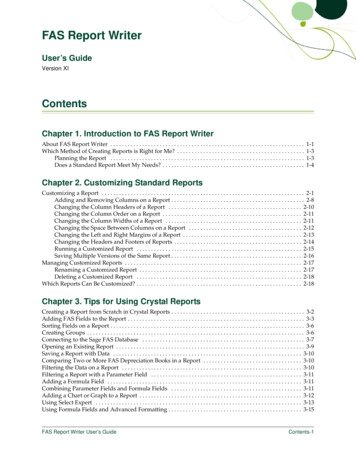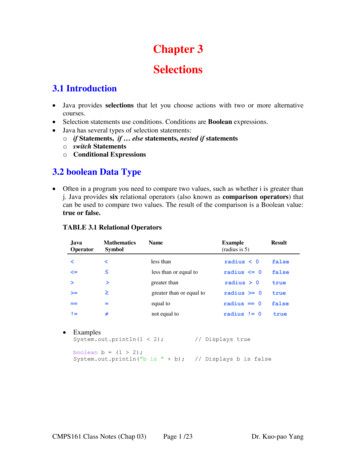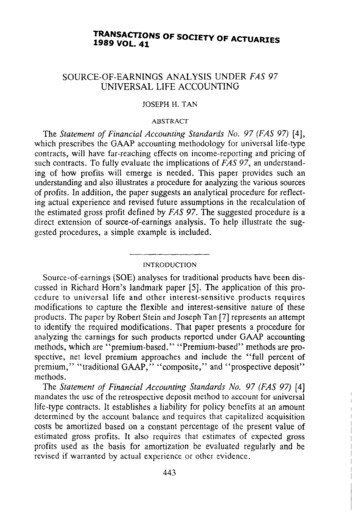
Transcription
TRANSACTIONS OF SOCIETY OF ACTUARIES1989 VOL. 41SOURCE-OF-EARNINGS ANALYSIS UNDER FAS 97UNIVERSAL LIFE ACCOUNTINGJOSEPH H. TANABSTRACTThe Statement of Financial Accounting Standards No. 97 (FAS 97) [4],which prescribes the GAAP accounting methodology for universal life-typecontracts, will have far-reaching effects on income-reporting and pricing ofsuch contracts. To fully evaluate the implications of FAS 97, an understanding of how profits will emerge is needed. This paper provides such anunderstanding and also illustrates a procedure for analyzing the various sourcesof profits. In addition, the paper suggests an analytical procedure for reflecting actual experience and revised future assumptions in the recalculation ofthe estimated gross profit defined by FAS 97. The suggested procedure is adirect extension of source-of-earnings analysis. To help illustrate the suggested procedures, a simple example is included.INTRODUCI'IONSource-of-earnings (SOE) analyses for traditional products have been discussed in Richard Horn's landmark paper [5]. The application of this procedure to universal life and other interest-sensitive products requiresmodifications to capture the flexible and interest-sensitive nature of theseproducts. The paper by Robert Stein and Joseph Tan [7] represents an attemptto identify the required modifications. That paper presents a procedure foranalyzing the earnings for such products reported under GAAP accountingmethods, which are "premium-based." "Premium-based" methods are prospective, net level premium approaches and include the "full percent ofpremium," "traditional GAAP," "composite," and "prospective deposit"methods.The Statement of Financial Accounting Standards No. 97 (FAS 97) [4]mandates the use of the retrospective deposit method to account for universallife-type contracts. It establishes a liability for policy benefits at an amountdetermined by the account balance and requires that capitalized acquisitioncosts be amortized based on a constant percentage of the present value ofestimated gross profits. It also requires that estimates of expected grossprofits used as the basis for amortization be evaluated regularly and berevised if warranted by actual experience or other evidence.443
444SOURCE-OF-EARNINGS ANALYSIS UNDER FAtS 97This paper analyzes the emergence of pretax GAAP profits and examinesthe fundamental income statement structure under FAS 97. The suggestedSOE analysis applicable to the FAS 97 universal life (UL) accounting methodology is demonstrated both with and without a revision in the amortizationschedule. This paper also proposes an analytical procedure for changing theestimated gross profit stream used to create the revised amortization schedule. To aid in the understanding of the suggested procedure, a simple example is included.OVERVIEW OF F A S 97 UNIVERSAL LIFE ACCOUNTINGIn December 1987, the Financial Accounting Standards Board (FASB)issued Statement of Financial Accounting Standards No. 97 (FAS 97) [4].This statement applies to investment contracts, substantially all limited-payment contracts, univeraI life-type contracts, and realized investment gainsand losses. However, this statement does not apply to contracts with termsthat are fixed and guaranteed and for which premium-paying periods are thesame as benefit periods, nor does it apply to accident and health products.Universal life-type contracts provide either death or annuity benefits andare characterized by any of the following: One or more of the amounts assessed by the insurer (for example, mortality charge)are not fixed and guaranteed by contract terms.Amounts that accrue to policyholder's benefit (for example, interest accrued to 1901icyholder balances) are not fixed and guaranteed by contract terms.Premiums may be varied by the policyholder within contract limits and withoutinsurer's consent.FAS 97 does not apply to a participating or a nonguaranteed premiumcontract unless the terms of the contract suggest that it is, in substance, auniversal life-type contract. Paragraphs 12 and 13 of FAS 97 describe somesituations in which a participating or a nonguaranteed premium contract isaccounted for as a universal life-type contract.FAS 97 provides that the liability for policy benefits for universal lifetype contracts be equal to the sum of: The balance that accrues to the benefit of the policyholdersAmounts assessed to compensate the insurer for services to be performed over futureperiodsAmounts previously assessed against policyholders that are refundable on contractterminationAny probable loss (premium deficiency) as described in FAS 60.
SOURCE-OF-EARNINGS ANALYSIS UNDER FAtS 97445Amounts assessed for services in the future should be reported as unearnedrevenue and recognized in income by using the same assumptions and factorsused to amortize capitalized acquisition costs. The initiation or front-end feeis an example of unearned revenue.For universal life-type contracts, FAS 97 provides that revenue includeamounts assessed against policyholders except for amounts assessed for future services. Expenses include benefit claims in excess of policyholderbalances, expenses of contract administration, interest accrued to policyholders, and amortization of capitalized acquisition costs.FAS 97 provides that capitalized acquisition costs be amortized by applying a constant amortization rate to each year's gross profit. The amortizationrate is determined by dividing the present value of capitalized acquisitioncosts at issue by the present value of the estimated gross profits at issue.The discount rate used is the rate of interest that accrues to policyholderbalances. As actual experience develops, the estimated gross profits and theamortization rate may have to be revised and the total amortization recordedto date adjusted. The interest rate used to comput e the present value of therevised estimated gross profits is either the rate in effect at inception or thelatest revised rate.FAS 97 requires that the estimated gross profit include the following amountsbased on best estimate and without provision for adverse deviation: Amountsexpected to be assessed for mortality less benefit claims in excess of relatedpolicyholder balancesAmounts expected to be assessed for contract administration cost (including acquisition costs not included in capitalized acquisition costs)Amounts expected to be earned from the investment of policyholder balances lessinterest credited to policyholder balancesSurrenderchargesOther expected assessments and credits.If significant negative gross profits are expected in any period, the presentvalue of estimated gross revenues, gross costs, or the balance of insurancein force is used as the base for computing amortization.APPLICABLE PRODUCTS AND ASSUMPTtONS USEDThe SOE analysis introduced in this paper applies to those products thatcan be accounted for under the FAS 97 universal life-type accounting. Examples of such products are: Universal lifeInterest-sensitivewhole life
446SOURCE-OF-EARNINGS ANALYSIS UNDER F A S 97Single-premium whole life with excess interest creditsSingle- and flexible-premium deferred annuitiesVariable life and annuityVariable universal life. Even though deferred annuity and variable annuity are classified as investment contracts during the accumulation stage, universal life-type accounting(that is, retrospective deposit method) can also be used. R e g a r d i n g variableproducts, some assumptions m a y need to be made regarding the c o m p u t a t i o nof some of the terms used in our S O E formulas. For instance, the interestearned rate, credited rate, and account balance should include the effects ofmarket value fluctuation.To simplify the presentation, the f o l l o w i n g assumptions are m a d e :1.2.3.4.5.6.7.8.9.10.11.12.A policy-year orientation is used.Premium, expenses (which include commissions), and expense charges occur atthe beginning of the policy year (BOY).Death and withdrawal occur at the end of the policy year (EOY).Invested assets equal the net GAAP reserve (that is, account balance less deferredacquisition cost). The extension to those cases in which assets are defined differently (for example, statutory reserve plus required surplus) are trivial. Essentially,an additional term representing interest on GAAP surplus will emerge.Mortality charge occurs at BOY and is based on the net amount at risk at BOY. Inreality, mortality charges may be deducted monthly and may be based on theamount at risk at the beginning of the month. The extension of our SOE formulasto the monthly case is more complicated but follows the same procedure.The death benefit does not increase with the increase in account balance.No rider is attached to the base policy.No other complications occur, for example, no policy loan, no partial withdrawal,no change in face amount other than at BOY.No significant negative gross profits are expected in any period. Hence, the amortization of deferred acquisition cost is based on estimated gross profit.Nonextra first-year expense consists of administrative expenses only.The only unearned revenue item is the front-end fee, which is called first-yearcharge in the paper.No extra reserve is needed for premium deficiency because the latter is not anticipated.NOTATIONA.qwSymbols M o r t a l i t y rate W i t h d r a w a l rate
S O U R C E - O F - E A R N I N G S ANALYSIS UNDER F A S 9 7mDBABCSVMCFYCC447Mortality charge rateDeath benefitAccount balanceCash surrender valueMortality chargeExtra first-year expense charge, also called front-end feeNonextra first-year expense charge, including all administrativecharges except front-end feeP Gross premiumFYE Extra first-year expenseE Nonextra first-year expense (administrative expense)i Earned interest ratel Survivorship function at time t, that is, units in force at time tl, l, l(lq, - w,)r Credited interest rateDE Deferrable expense, as defined in FAS 60DAC Outstanding deferred acquisition costV Net G A A P reserve A B - DACA ChangePf ProfitG Estimated gross profit used to derive the amortization schedule,as defined in FAS 97 Paragraph 23. (To avoid confusion withG A A P profit Pf, we refer to G as gain.)Except for q, m, w, r, and i, values are per unit in force at time t.B.tC AG Subscriptdenotes policy year t.For some terms, the subscript is omitted if there is no ambiguity.Superscripts Actual experience G A A P assumption, which is based on the best estimate of futureexperience, that is, expected.For some terms, the superscript is omitted if there is no ambiguity.Refer to Appendix I for a complete list of notation used in this paper.
448SOURCE-OF-EARNINGSANALYSISUNDERFAS 97EXPECTED GAAP PROFITSW e will derive the e x p e c t e d G A A P profit for y e a r t when actual experience conforms to the G A A P assumption (which is also the best estimate o fexpected experience, without adverse deviation provision). Let us first c o n sider how the universal life (UL) i n c o m e statement looks under F A S 9 7 .Income Stalcfllel ]IcrrlsExpectedG A A P Profit Mortality chargeSurrender chargeAdministrative chargeEarned interest-(Death benefit-accountbalance released due to death)Administrative expenseFirst-year expenseCredited interest-Symbols MC w(AB, - CSV,) C i(V, PE- FYE)- q(DB, - AB,)-E-FYE- AB, P - MC- Deferrable expense Amortization o f unamortized deferred expense-- Amortization of unamortized first-year chargec-FYC) DE ADE-AFYCNote that:1.3.For ease of presentation, the values shown under the Symbols column (except form, w, p; and i) are expressed as per unit in force at B O Y t . To obtain the aggregatevalues for the company, we simply multiply the terms by the outstanding in forceat B O Y t (that is, l, ). The l,'s notation has been omitted in this section to minimizethe amount of symbols.FYC, FYE, and D E are zero except for the first year. The extension to the case inwhich some of these items are nonzero beyond the first year is trivial.A B , A B , E P credited interest - MC - FYC - C.4.M C m (DB, 1 - A B ,5.The superscript is not used in the above symbols because all the values in this sectionare expected and have superscript G.q,2.i).Rearranging and settingADACw e have ADE-AFYC,
SOURCE-OF-EARNINGS ANALYSIS UNDERExpected G A A P profit MC -449FAS 97- q(DB, - AB,)w(AB, - CSE)[c - e - (YYe - De)]i(V, P - E - FYE)r(AB, t PMCC -FYC) aoAc,.(1)Note:(i) If D E F Y E , then the third term reduces to ( C - E ) . Otherwise, ( F Y E - D E ) isan extra first-year loss.(ii) F Y E , D E , and FYC are zero for t 1.(iii) A DAC, (1 - q, - w , ) D A C , - DAC, I r D A C , - (.4%)G,(2)where G, the t-tlt year estimated gross profit used to amortizeDAC,perFAS97 (to avoid confusion with GAAP profit, we refer to G, as gain),andDE(A ) --FYCy . v ' p G , p (1 - qs - w,) s- pAccording to F A S 9 7 , the t-th year gain (estimated gross profit) is to becomputed as:SymbolsG, MC,-q, (DO, - AB,)DescriptionGain from mortality (GM) w, (AE - csv,)Gain from withdrawal (GW) [C, - E, -Gain from expense (GE)(FYE - DE)] i, (AB, I P, - E, - FiE). - r, ( A B , , P, - M C , - C, - F Y C )Gain from interest (GI)(3)Substituting Equations (2) and (3) into (1), w e see that the expected G A A Pprofit for year t is
450SOURCE-OF-EARNINGS ANALYSIS UNDER F A S 97Pf G, zXDAC, - it DACtPf,, (1 - A % ) G ,- (i, - r,) DACt ,.(4)Whereas expected profit under a traditional G A A P approach emerges asa fixed percentage of gross premium (plus the release of margins for adversedeviation), expected profit under FAS 97 U L accounting [see Equation (4)]emerges as the sum of:1.2.A percentage of gain (that is, estimated gross profit), such percentage is equal tothe complement of the DAC amortization rate, or (1 - A%).The loss due to interest spread on the BOY DAC. This term emerges because DACis discounted by using the credited rate r, but the net GAAP reserve (AB - DAC)earns interest at the earned rate i.Of course, this expected profit will emerge only if all G A A P assumptionsare realized. If some or all of the G A A P assumptions are not realized,variations from this expected profit level will emerge. As shown in the nextsection, these variations can be traced to various specific sources of profit.It should be pointed out that the above derivation of expected profit assumed two interpretations of the calculation of t-th year gain (that is, theestimated gross profit as described in FAS 97 Paragraph 23).Interpretation 1:The gain from expense, GE, of Equation (3) # net of(FYE - DE) in the first year.In other words, the nondeferrable expense (including first-year nonpolicyrelated overhead expense) is netted out in the computation of first-year GE.Although this is in line with the literal provision of FAS 97 Paragraph 23b,some practitioners argue that this is not the intention of FAS 97. Theirreasons are as follows:a) The phrase used in FAS 97 Paragraph 23b that reads "acquisition costs not includedin capitalized acquisition costs" should be interpreted to mean "recurring" acquisition cost, not first-year nondeferrable acquisition cost.b) Interpretation 1 varies from the usual procedure used under the traditional GAAPapproach. FAS 60 Paragraph 27 states that "Costs i n c u r r e d . . , that do not varywith and are not primarily related to the acquisition., shall be charged 2o expenseas incurred" [3]. It can be argued that to fully charge the nondeferrable expenses asthey are incurred, the nondeferrable expenses should not be part of the gain (estimated gross profit). This is the case with the traditional GAAP reserve, whoseformula excludes any assumption regarding nondeferrable expense and which allowsthe nondeferrable expense to flow into first-year GAAP profit dollar-for-dollar. Although the FAS 97 amortization base of gross profits differs from FAS 60's base ofpremiums, there is no indication that FASB intended that nondeferrable expense beconsidered in amortizing DAC.
S O U R C E - O F - E A R N I N G S A N A L Y S I S UNDER F A S 97451c) The use of Interpretation 1 is likely to lead to negative first-year gain (estimatedgross profit). This is particularly true for annuities, because annuities have minimalfirst-year gain from mortality (GM). Even if negative first-year gain does not occur,the inclusion of nondeferrabie expense will reduce first-year amortization and increase subsequent amortization and increase the likelihood of a loss recognitionsituation.If the reasoning of these practitioners is correct and if (FYE - DE) is notto be netted out in the first-year GE, then our expected GAAP profit formulawould become, for t 1,If, (1 - A%)G, - (i, - r,)DAC, ,and for t 1,Pf, (1 - A%)G - (i, - r,)DAC , - (FYE - DE)where the last item is the loss due to nondeferrable expense in the first year,which flows into profit 100 percent. Note thatA% and G in the last equationare different from those of Equation (4).Interpretation 2." The interest earned portion of the gain from interest, GI,of Equation (3) is the interest earning on BOY AB plusthe change in cash flow during the year.The interest earning on the change in cash flow has been included becauseit can be argued that an insurance company earns interest on the asset itholds at BOY (which is assumed to be equal to B O Y A B in the computationof estimated gross profit) plus the change in cash flow during the year. Thatis, because an insurance company invests any net cash flow during the year,the projection of the estimated gross profit should include the interest earningfrom such investment. This thinking is also more in line with other actuarialformulas, for example, asset share, book profit, and so on. Hence, it canbe argued that Interpretation 2 is a refinement of the wording of Paragraph23c.For those readers who disagree with Interpretation 2 and who prefer toapply the wording of Paragraph 23c literally, the interest earned portion ofthe gain from interest, GI, of Equation (3) should be changed toi, (AB, , P, - MC, - C, - FYC).In this case, it can be shown that the expected GAAP profit for year t willbe equal to Equation (4) less
452S O U R C E - O F - E A R N I N G S ANALYSIS UNDER F A S 9 7i,[(E, -C, - MC,) (FYE - FYC)].Note that in reality, the magnitude of this term will generally be reduced byhalf, because most expenses and charges often occur evenly throughout theyear.In the remaining discussion, we assume that Interpretations 1 and 2 hold;hence expected GAAP profit is as shown in Equation (4). If either Interpretation 1 or 2 or both are violated, adjustments to the SOE formulas shownin the next section should be made. The development of such adjustmentsis not difficult.S O U R C E - O F - E A R N I N G S ANALYSISA . Calculation of Total Expected ProfitBecause the SOE analysis is a procedure for analyzing the deviation ofactual versus expected profit, we first need to define how expected profit iscalculated. Taking expected to mean expected based on GAAP (best estimate) assumptions, there are two methods for calculating total expectedprofit for the company:Method 1Expected in force times the expected profit per in force,ict-I p 7tc. ,that is, the t-th year expected profit for the company is computed as theexpected in force at B O Y t times the t-th year expected profit per unit inforce at B O Y t.Method 2Actual in force times the expected profit per in force,l ., I pfc/.Due to the difference in actual versus expected mortality and lapse rates,the actual in force at B O Y t will be different from expected. The Method 2calculation of total expected profit is dynamic; that is, it adjusts for thedifference in actual versus expected in force.In actual practice, the difference in the two methods will be temporaryand perhaps minimal. This is due to the "unlocking" provision of FAS 97Paragraph 25, which requires that the GAAP assumption be evaluated and
S O U R C E - O F - E A R N I N G S ANALYSTS UNDER F A S 97453revised regularly. For instance, if the GAAP assumption is revised everyyear-end, there is no difference in the two methods.The author prefers Method 1 because: It is the total expected profit based entirely on GAAP (best estimate) assumptions,that is, not adjusted. The resulting SOE formulas of Method 1 are easier to understand. Unless the estimated gross profit and DAC schedule are revised, the application ofFAS 97 will normally be based on the static DAC calculation procedure (that is,using the original DAC schedule regardless of the actual versus expected in force).Because of this requirement, the author believes that adjusting the total expectedprofit based solely on the deviation between actual versus expected in force (that is,without revising the estimated gross profit) is inappropriate.Note that the last point is generally not a problem under the traditional GAAPapproach, because the latter often uses either the dynamic worksheet methodor the factor method to amortize D A C . Hence, under the traditional GAAPapproach, the expected GAAP profit per unit in force generally does notchange regardless of the difference between actual versus expected in force(unless the static D A C worksheet procedure is used).Nevertheless, the author realizes that there are benefits associated withthe Method 2 calculation of total expected profit (for example, ease of calculation) and that some readers may prefer the Method 2 calculation. Forthese reasons, the SOE procedure using the Method 2 calculation of totalexpected profit is included in Appendix II. Note that because of the staticnature of D A C amortization under F A S 9 7 (unless a revision in D A C amortization is made), there is an extra item in the SOE formula shown inAppendix II. This extra item effectively adjusts D A C for the deviation ofthe actual versus expected in force.The remainder of the paper is based on the Method 1 calculation of totalexpected profit. Hence, the t-th year total expected profit isB. Source-of-Earnings AnalysisThe total actual profit for year t, excluding the effects of changes in D A Cbalances due to revisions of estimated gross profits, can be expressed asl{ , Pf, l.; M C A -lA, , q ' (DB ,' - ABe,') IA, , w a ( A B A, -CSV ')
454S O U R C E - O F - E A R N I N G S ANALYSIS U N D E R F A S 9 7 l ,[CA -EA -(FYE A - t , ,iA(AB ,, p'-z ,, r ( A B e , , n,, M C A --l ., (i A D A CO,' ,) t ,-DE )]E -FYE ,)C F Y C ) DACf (5)We see that most of the terms of Equation (5) are multiplied by the actualin-force of the company. The only exceptions are P D A C and 2 x D A U ,which are multiplied by the expected in-force. Without a revision in theestimated gross profits, D A C amortization would be static; that is, the totalamortized amount for the company would not be adjusted according to actualversus expected in force. For the same reason, we note that the total actualnet GAAP reserve, V, is equal to total actual A B less total expected D A C .That is,t V4 pl AB Il c, D A C .By rearranging terms, we can write the total actual profit for year t as follows,where the l's represent the in-force at B O Y t and have subscript t - 1:Synlbols Py , U (l - A( %) G c;DescriptionExpected % gain profit-- t (i, - rf, ) DAC, ,Expected interest spread loss on B O Y D A C (PGM Variation due to gain from mortality (VGM)- U G M , G)(tA c,w - t c ; )Variation due to gain from withdrawal ( V G VO (lA GE, 4 - l G U / )Variation due to gain from expense (VGE) (tA GI A, - t a G l , 6)Variation due to gain from interest (VGI)- l'; (i , - i,c') DACI;-,Variation due to interest earnings on B O Y D A CLet us look at each of these items.1. E x p e c t e d P r o f i tAs discussed earlier, the first two terms (that is, expected % gain profitand expected interest spread loss on D A C ) comprise the expected GAAPprofit under the F A S 9 7 UL accounting. This corresponds to the percentageof premium profit expected under traditional GAAP accounting.
455S O U R C E - O F - E A R N I N G S ANALYSIS UNDER F S 972. V a r i a t i o n s D u e to G a i n f r o m M o r t a l i t y(VGM)This is simply the excess of actual over expected gain from mortality:lA [ M C - (DB;-AB:)]-U [MC G -q (DBC, ' -ABC,')].In actual practice, unless the mortality charge rate, m, is revised, the difference between actual and expected mortality charges will normally beimmaterial. Thus, the main contributor to V G M will be the variance betweenexpected and actual mortality rates (qC, qA). Clearly, V G M is also affectedby the actual versus expected relationship between D B and A B , althoughsuch effect is not as great because m and q work in opposite directions.Also, the difference between lA and l G contributes additional profit, althoughthis is not material if GAAP assumptions are updated frequently.3. V a r i a t i o n s D u e to G a i n f r o mWithdrawal(VGW)This is equal to the excess of actual over expected gain from withdrawal:l w ( A B :-C S V ,A) -1G w c (AB,c" -CSW,').Except for some peculiar contracts (for example, those with bailout provisions or other features that waive or decrease the surrender charge collected),the surrender charge scale cannot be revised once the policy is issued. Hence,V G W variation can only result from three causes:(a) The difference between actual and expected account balances gives rise to a deviation between actual and expected surrender charges collected at surrender.(b) The difference between actual and expected in force at BOY.(c) The variance between actual and expected withdrawal rates.Of these three causes, the last one is often the major cause for V G W .4. V a r i a t i o n s D u e to G a i n f r o m E x p e n s e(VGE)This is equal to the difference between the actual and expected excessesof expense charges over expenses and nondeferrable first-year expense:l A [C -E4 -(FYE A -DEA)] -l c; [C c" -U;-(FYE 6 -DEC')].Because expense charges can be changed only according to contract specifications, the deviation between actual and expected charges likely will besmall, and the deviation between actual and expected expenses will be themajor cause of V G E . For the first year, the difference between actual versusexpected nondeferrable expenses has a material effect on V G E . Again, we
456S O U R C E - O F - E A R N I N G S ANALYSIS UNDER F A S 97see that the difference in B O Y actual versus expected in force has someimpact on V G E .Note that the earned and credited interest on expenses and expense chargesare not included in V G E , but are included in V G I . This is done to preservethe symmetry with Equation (3), the computation of the components ofestimated gross profits, G M , G W , G I , and G E .5. V a r i a t i o n s D u e to G a i n f r o m(VGI)InterestThis is the excess of actual over expected interest spreads:l A [iA ( A B : ,- P -r a (AB: P EA -MC A -C " -Ec -FYE c)-- l c' [i c" (AB I x : -r c (ABF., p vF Y E m)MC cCcFYCA)]FYCC,)].Except for the earlier durations, the major cause of V G I will be the excessof the actual over the expected spread earned on B O Y A B ,l A (i A -r )ABA,-U ( i c" -r )AB,6,.In practice, the interest credited rate is often declared on a monthly orquarterly basis. Knowing that the actual earned rate has deviated from expected, the actuary can use the V G I formula to determine the credited ratethat will give rise to zero V G I .6. V a r i a t i o nD u e to I n t e r e s t E a r n i n g sonBOY DACBecause our model assumes that invested assets are equal to the net GAAPreserve (that is, A B minus D A C ) , the deviation between actual and expectedearning rates also will give rise to a deviation in actual and expected interestloss on the D A C balance.It may be helpful to combine this item (that is, D A C interest earningdeviation) with the previous item (that is, V G I ) . The sum of these two itemscan be rewritten as:lA [iA ( VA 1 P ' - Ea - FYEA)-t-r (ABA(K',r (ABT, pA p6MC A-E-CAFYCA)]FIE ,)MC GC FYCO)].(6)We see that while the deviation in credited rates is applied to A B , thedeviation in earned rates is applied to A B less D A C (that is, net GAAP
SOURCE-OF-EARNINGS ANALYSIS UNDER F A S 97457reserve). Knowing that the actual earned rate deviates from expected, theactuary can apply the above formula to determine the credited rate that willyield the expected GAAP profit. For instance, if the objective is to have noadditional interest gain or loss, the above formula should be set to zero andsolved for the appropriate r .To summarize, we note that the total actual GAAP profit for year t islA P total expected profit for year t (/AC4,' -/ " CfD- lG(if - i,c') D A C e ,(7)whcreG G M G W GE GI the t-th year gain (consisting of four components:mortality, withdrawal, expense, and interest)l in force at B O Y t .The second term of Equation (7) represents the variation due to the gains(that is, estimated gross profits) from four components: mortality, withdrawal, expense, and interest. The last term of Equation (7) represents thevariation in profit caused by the actual versus expected interest earnings onB O Y D A C . Over time, as existing GAAP assumptions become more outdated, these two terms, which represent the variations between actual andexpected profits, may increase. This may signal the need to revise the existing GAAP assumptions.REVISING F A S 97 ESTIMATED GROSS PROFITS AND DAC SCHEDULESThe previous development ignores the "unlocking" aspect of F A S 97,which states that"Estimates of estimated gross profit . . . . and the total amortization recorded todate . . . . shall be adjusted., if evidence suggests that earlier estimates should berevised."If such a revision is made at E O Y n, the following term, representing thevariation due to revised D A C amortization, should be added to Equations(5) and (7):I G' D A C e- U DAC Gwhere primed notati
The Statement of Financial Accounting Standards No. 97 (FAS 97) [4], which prescribes the GAAP accounting methodology for universal life-type contracts, will have far-reaching effects on income-reporting and pricing of such contracts. To fully evaluate the implications of FAS 97, an understand-
